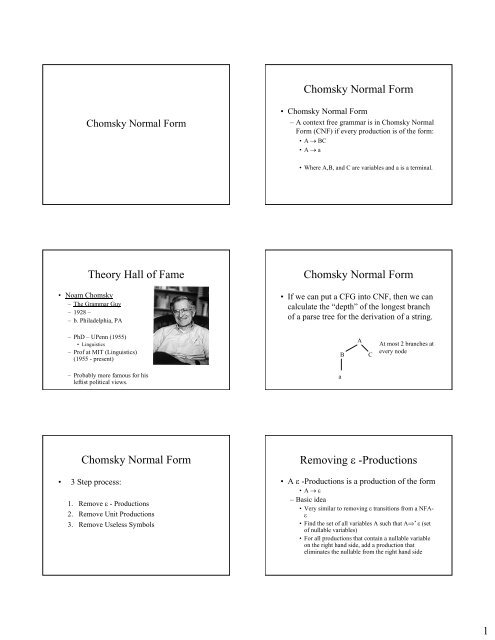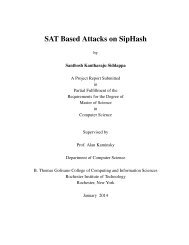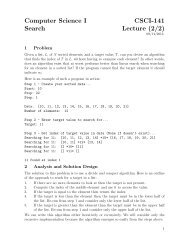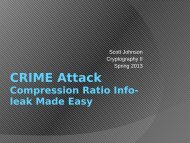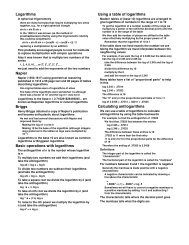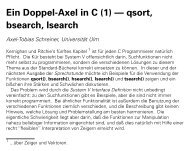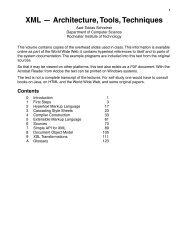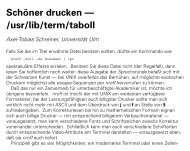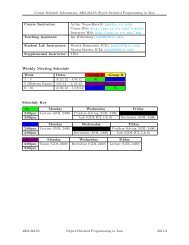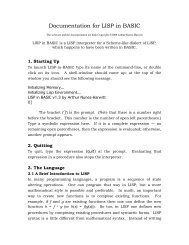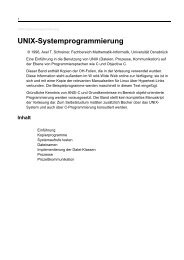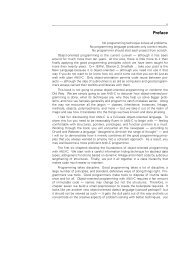Chomsky Normal Form
Chomsky Normal Form
Chomsky Normal Form
You also want an ePaper? Increase the reach of your titles
YUMPU automatically turns print PDFs into web optimized ePapers that Google loves.
<strong>Chomsky</strong> <strong>Normal</strong> <strong>Form</strong><br />
Theory Hall of Fame<br />
• Noam <strong>Chomsky</strong><br />
– The Grammar Guy<br />
– 1928 –<br />
– b. Philadelphia, PA<br />
– PhD – UPenn (1955)<br />
• Linguistics<br />
– Prof at MIT (Linguistics)<br />
(1955 - present)<br />
– Probably more famous for his<br />
leftist political views.<br />
<strong>Chomsky</strong> <strong>Normal</strong> <strong>Form</strong><br />
• 3 Step process:<br />
1. Remove ε - Productions<br />
2. Remove Unit Productions<br />
3. Remove Useless Symbols<br />
<strong>Chomsky</strong> <strong>Normal</strong> <strong>Form</strong><br />
• <strong>Chomsky</strong> <strong>Normal</strong> <strong>Form</strong><br />
– A context free grammar is in <strong>Chomsky</strong> <strong>Normal</strong><br />
<strong>Form</strong> (CNF) if every production is of the form:<br />
•A → BC<br />
•A → a<br />
• Where A,B, and C are variables and a is a terminal.<br />
<strong>Chomsky</strong> <strong>Normal</strong> <strong>Form</strong><br />
• If we can put a CFG into CNF, then we can<br />
calculate the “depth” of the longest branch<br />
of a parse tree for the derivation of a string.<br />
a<br />
A<br />
B C<br />
At most 2 branches at<br />
every node<br />
Removing ε -Productions<br />
•A ε -Productions is a production of the form<br />
•A →ε<br />
– Basic idea<br />
• Very similar to removing ε transitions from a NFAε<br />
• Find the set of all variables A such that A⇒ * ε (set<br />
of nullable variables)<br />
• For all productions that contain a nullable variable<br />
on the right hand side, add a production that<br />
eliminates the nullable from the right hand side<br />
1
Removing ε -Productions<br />
• We must be a bit careful here<br />
– If ε is in a CFL, then the production S → ε<br />
must be in the production set.<br />
– The algorithm to be described will generate L –<br />
{ε}<br />
Removing ε -Productions<br />
• Step 2: Remove nullable variables<br />
– For all productions A → βwhere β contains<br />
nullable variables, add a new production with<br />
each nullable removed from β<br />
Removing ε -Productions<br />
• Step 2: Remove nullable variables Example:<br />
– Consider: S → AB<br />
• Add to P: S → A and S → B<br />
– Consider: A → aAA<br />
• Add to P: A → aA and A → a<br />
– Consider: B → bBB<br />
• Add to P: B → bB and B → b<br />
Removing ε -Productions<br />
• Step 1: Find the set of nullable variables:<br />
– Example:<br />
•S→ AB<br />
•A → aAA | ε<br />
•B → bBB | ε<br />
• All variables are nullable<br />
– A and B are nullable since A → εand B → ε<br />
– S is nullable since S → AB and A and B are nullable<br />
Removing ε -Productions<br />
Step 2: Remove nullable variables Example:<br />
•S→ AB<br />
•A → aAA | ε<br />
•B → bBB | ε<br />
• All variables are nullable<br />
Removing ε -Productions<br />
• Step 2: Remove nullable variables<br />
– Our grammar now looks like:<br />
•S→ AB | A | B<br />
•A → aAA | aA | a | ε<br />
•B → bBB | bB | b | ε<br />
2
Removing ε -Productions<br />
• Step 3: Remove your ε -Productions<br />
– Example:<br />
• Remove A →εand B →ε<br />
• Our final grammar looks like:<br />
–S→ AB | A | B<br />
–A → aAA | aA | a<br />
–B → bBB | bB | b<br />
– Questions?<br />
Removing Unit Productions<br />
• Step 0: Remove ε -Productions using the<br />
previous algorithm.<br />
Removing Unit Productions<br />
• Step 1: For all variables A find the set of Aderivable<br />
variables:<br />
–Example:<br />
• S → S + T | T<br />
• T → T * F | F<br />
• F → (S) | a<br />
• Let’s find the set of S-derivable variables:<br />
– T is S derivable since S → T<br />
– F is S derivable since T → F and T is S derivable<br />
Removing Unit Productions<br />
• A Unit Productions is a production of the<br />
form<br />
•A → B where A and B are variable<br />
– Basic idea<br />
• Very similar to removing ε productions<br />
• For each variable A, find the set of all variables B<br />
such that A⇒ * B by just following unit productions<br />
(A-derivable)<br />
• For all variables B that are A derivable and for all<br />
productions B → α, add the production A → α<br />
Removing Unit Productions<br />
• Step 1: For all variables A find the set of<br />
A-derivable variables:<br />
– Recursive definition of A-derivable<br />
1. If A → B then B is A-derivable<br />
2. If C is A derivable and C → B (and B ≠ A), then B<br />
is A derivable<br />
3. No other variables are A-derivable.<br />
Removing Unit Productions<br />
• Step 1: For all variables A find the set of Aderivable<br />
variables:<br />
–Example:<br />
• S → S + T | T<br />
• T → T * F | F<br />
• F → (S) | a<br />
• S-derivable = {T, F}<br />
• T-derivable = {F}<br />
• F-derivable = ∅<br />
3
Removing Unit Productions<br />
• Step 2: For each variable A, if B is Aderivable,<br />
for each non-unit production B<br />
→β, add the production A → β<br />
Removing Unit Productions<br />
• Step 2:<br />
– Our new grammar now looks like:<br />
•S → S + T | T * F | (S) | a | T<br />
•T → T * F | (S) | a | F<br />
•F → (S) | a<br />
Removing Useless Symbols<br />
• A symbol X is useful for a grammar G = (V, T, P,<br />
S) if<br />
–S ⇒ * αXβ⇒ * w where w ∈ L(G)<br />
• In other words, a useful symbol will be used<br />
somewhere in the derivation of a string in the<br />
language.<br />
• Any symbol that is not useful is useless.<br />
• Useless symbols do not add to the language<br />
generated by a grammar, so it’s okay to remove<br />
them.<br />
Removing Unit Productions<br />
• Step 2:<br />
–Example:<br />
• S → S + T | T<br />
• T → T * F | F<br />
• F → (S) | a<br />
• S-derivable = {T, F}<br />
• T-derivable = {F}<br />
• Add to P: S → T * F, S → (S) | a<br />
• : T →(S) | a<br />
Removing Unit Productions<br />
• Step 3: Remove Unit Productions<br />
– Our final grammar looks like:<br />
– Our new grammar now looks like:<br />
•S → S + T | T * F | (S) | a<br />
•T → T * F | (S) | a<br />
• Remove S → T, T → F<br />
– Questions<br />
Removing Useless Symbols<br />
• Definitions:<br />
– We say a symbol X is generating if:<br />
•X ⇒ * w for some w ∈ L(G)<br />
– We say a symbol X is reachable if:<br />
•S ⇒ * α Xβ for some α, β<br />
• Symbols that are useful must be both<br />
generating and reachable.<br />
– Such symbols (and assoc. productions) can be<br />
removed<br />
4
Removing useless symbols<br />
• Algorithm:<br />
1. Eliminate all non generating symbols<br />
2. Eliminate all non reachable symbols from<br />
resultant grammar.<br />
Removing useless symbols<br />
• Finding reachable symbols<br />
1. S is reachable<br />
2. If A is reachable, and A →α, then all<br />
variables in α are reachable.<br />
Removing useless symbols<br />
• Example:<br />
S → a<br />
A → b<br />
– Now A is not reachable, eliminate it!<br />
S → a<br />
Note that you must eliminate non-generating symbols<br />
before non-reachable symbols.<br />
Removing useless symbols<br />
• Finding generating symbols<br />
1. All symbols in T are generating<br />
2. If A →α and all symbols in α are<br />
generating, then A is generating.<br />
3. No other symbols are generating.<br />
Removing Useless Symbols<br />
• Example:<br />
S → AB | a<br />
A → b<br />
B is useless since it is not generating<br />
Eliminate it<br />
Recall our goal<br />
• <strong>Chomsky</strong> <strong>Normal</strong> <strong>Form</strong><br />
– A context free grammar is in <strong>Chomsky</strong> <strong>Normal</strong><br />
<strong>Form</strong> (CNF) if every production is of the form:<br />
•A → BC<br />
•A → a<br />
• Where A,B, and C are variables and a is a terminal.<br />
5
<strong>Chomsky</strong> <strong>Normal</strong> <strong>Form</strong><br />
• Given a CFG G, there is an equivalent CFG,<br />
G’ in <strong>Chomsky</strong> <strong>Normal</strong> form such that<br />
– L(G’) = L(G) – {ε}<br />
<strong>Chomsky</strong> <strong>Normal</strong> <strong>Form</strong><br />
• After steps 1 – 3 :<br />
– All productions are of the form:<br />
• A → a where A is a variable and a is a terminal<br />
• A →βwhere | β | ≥ 2 and β contains variables and/or<br />
terminals.<br />
– Step 4: Derive terminals from new variables:<br />
• For all productions of the 2 nd type: A → β, for all terminals a<br />
in β, create a new variable X a<br />
• Add a new production X a → a<br />
• Replace a in β with X a<br />
<strong>Chomsky</strong> <strong>Normal</strong> <strong>Form</strong><br />
• Step 4:<br />
– Define new productions: X a → a and X b → b and<br />
replace instance of a with X a , similarly for b<br />
–S→ AB | aAA | aA | a | bBB | bB | b<br />
–A → aAA | aA | a<br />
–B → bBB | bB | b<br />
• New:<br />
–S→ AB | X a AA | X a A | a | X b BB | X b B | b<br />
–A → X a AA | X a A | a<br />
–B → X b BB | X b B | b<br />
–X a → a<br />
–X b → b<br />
• Step 1:<br />
<strong>Chomsky</strong> <strong>Normal</strong> <strong>Form</strong><br />
– Remove ε -Productions<br />
• Step 2:<br />
– Remove Unit Productions<br />
• Step 3:<br />
– Remove useless symbols<br />
<strong>Chomsky</strong> <strong>Normal</strong> <strong>Form</strong><br />
• Step 4:<br />
– Let’s go back to our first example:<br />
–S→ AB | A | B<br />
–A → aAA | aA | a<br />
–B → bBB | bB | b<br />
• Removing unit transitions:<br />
–S→ AB | aAA | aA | a | bBB | bB | b<br />
–A → aAA | aA | a<br />
–B → bBB | bB | b<br />
• Note that S, A, and B are all useful.<br />
<strong>Chomsky</strong> <strong>Normal</strong> <strong>Form</strong><br />
• After steps 1 – 4 :<br />
– All productions are of the form:<br />
•A → a where A is a variable and a is a terminal<br />
•A →βwhere | β | ≥ 2 and β contains only variables.<br />
– Step 5:<br />
• For all productions of type 2 where | β | > 2 , replace<br />
the production with a series of new productions each<br />
having exactly 2 variables on the right<br />
• Best illustrated with an example<br />
6
<strong>Chomsky</strong> <strong>Normal</strong> <strong>Form</strong><br />
• Step 4:<br />
– The production:<br />
•A → BCDBCE<br />
– Would be replaced with<br />
•A → BY 1<br />
•Y 1 →CY 2<br />
•Y 2 →DY 3<br />
•Y 3 → BY 4<br />
•Y 4 → CE<br />
<strong>Chomsky</strong> <strong>Normal</strong> <strong>Form</strong><br />
• Step 4:<br />
– Our final grammar<br />
–S→ AB | X a Y 1 |X a A | a | X b Y 2 |X b B | b<br />
–A → X a Y 1 |X a A | a<br />
–B → X b Y 2 |X b B | b<br />
–Y 1 → AA<br />
–Y 2 → BB<br />
–X a → a<br />
–X b → b<br />
– Questions<br />
Questions?<br />
• Next time<br />
– The Return of the pumping lemma<br />
<strong>Chomsky</strong> <strong>Normal</strong> <strong>Form</strong><br />
• Step 4:<br />
– Back to our example<br />
–S→ AB | X a AA |X a A | a | X b BB |X b B | b<br />
–A → X a AA |X a A | a<br />
–B → X b BB |X b B | b<br />
–X a → a<br />
–X b → b<br />
– Add productions<br />
•Y 1 → AA<br />
•Y 2 →BB<br />
CNF<br />
• Any grammar can be placed into CNF<br />
• Why bother?<br />
– Remember that awful CFG we generated last<br />
week?<br />
• Simplification<br />
– Gives upper limit on size of parse tree<br />
• Pumping Lemma will need this.<br />
7


